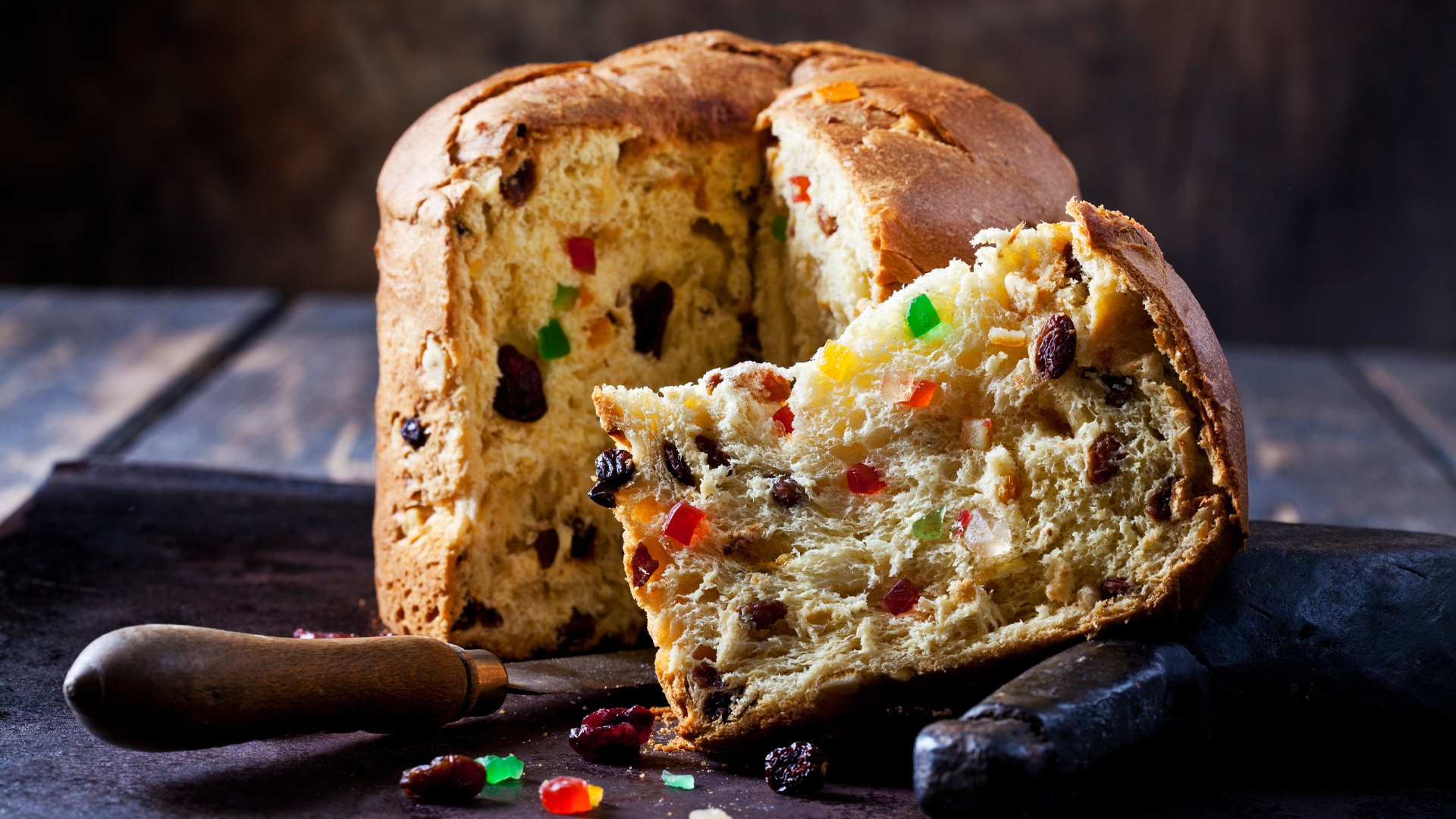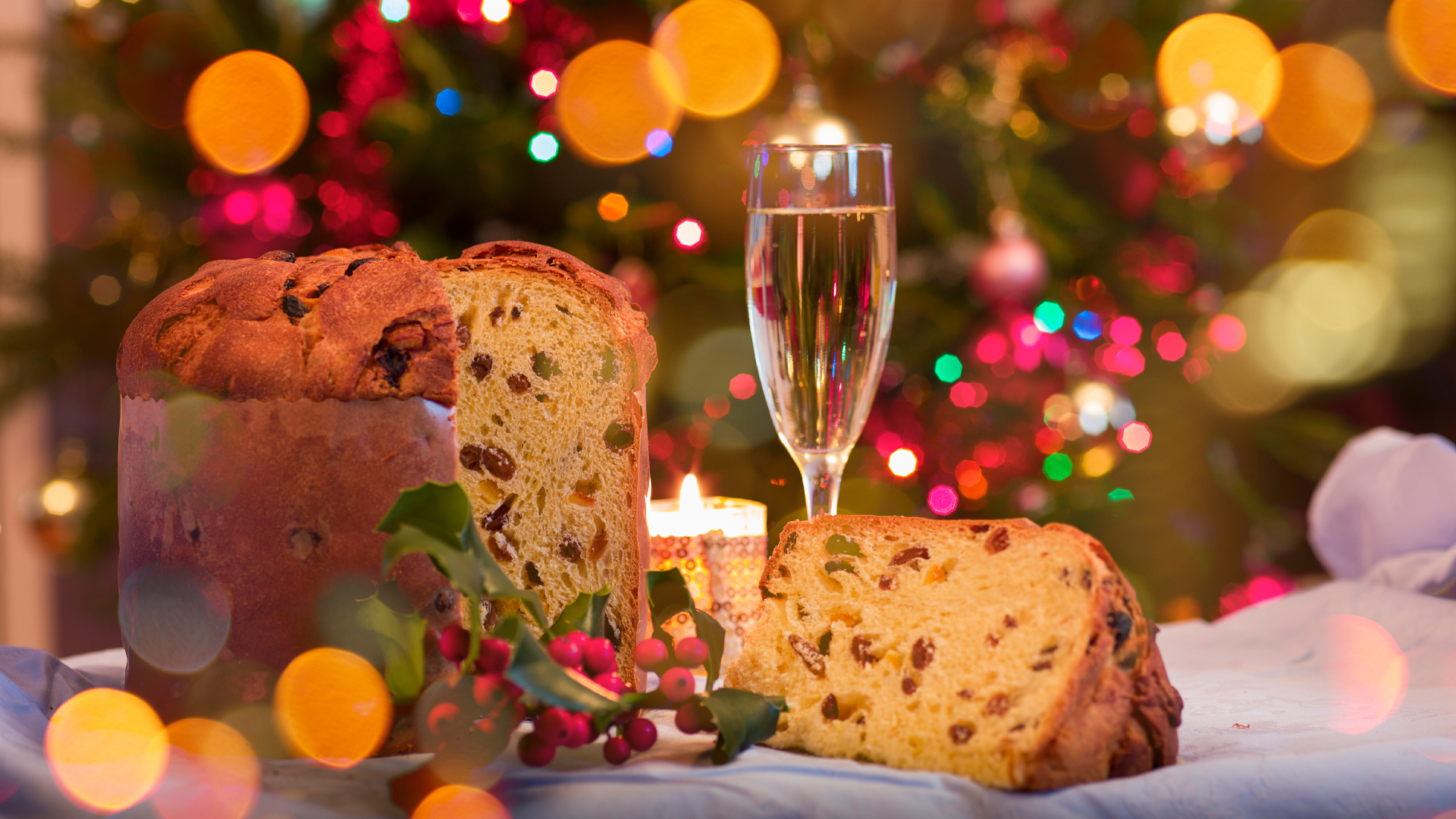The Christmas season wouldn't be complete without a slice of panettone, a sweet, fluffy bread filled with candied fruits. Invented in Milan, the dome-shaped bread has become a symbol of Christmas for Italians around the world.
The term panettone means a large bread or cake, a name earned by the large rounded top. It's said that the dome resembles the shape of a cathedral cupola. Today, Italians regulate the ratio of candied fruit, butter, and eggs in panettone. The classic flavor of panettone contains candied citrus and sauternes, sweet golden raisins, but new variations with have sprung up wherever the bread was baked.
Panettone as we think of it today originated in Milan, but Romans baked a similar cake-like bread made with honey. It is also similar to Kugelhopf, a German cake made from enriched dough. However, the first real recipe for Panettone appears in Bartolomeo Scappi's collection in the 1500s. At the time, Panettone's secret ingredient was a base of all wheat flour. Most breads then were baked using large amounts of cheaper flours like rye, oats, and spelt. These grains were easier to grow and produced higher yields, but the bread tougher and less luxurious than all-wheat bread.
Panettone's link to Christmas also dates back to the 15th century. On Christmas Eve in the Lombard region, the family patriarch would traditionally slice bread and share it with family members, each eating a piece to ensure good luck in the new year. Ludovico Sforza, Duke of Milan, had planned on celebrating this way with his family. However, as one legend goes, the household chef burned the bread intended for Christmas Eve. Replacing the burned bread then fell to a lowly kitchen assistant named Toni. He took an ordinary sourdough starter, enriched it with eggs and butter, and then added raisins to create substitute bread. The Duke’s family loved the bread so much that they named it in honor of the kitchen boy.

(Photo Credit: katya rumyantseva via Unsplash)
Another legend claims the bread was created when a nobleman, Ughetto della Atellani, fell in love with a poor baker's daughter, Adalgisa. Ughetto's family disapproved of a marriage. But since he was in love, Ughetto took a job in the bakery in an effort to woo Adalgisa’s affection anyway. At Christmas, he added candied fruits to the bread, and his new recipe proved popular. The baker grew rich selling it, and once Adalgisa's wealth and status were secure, Ughetto was allowed to marry her.
A third myth claims Ughetto was actually Sister Ughetta, a nun who baked the fruit-filled bread for the other sisters in the convent. The impoverished nuns had expected a sad Christmas dinner brightened by the fruit-fille bread.
Another version of the story was created in 1989 by the Tomie DePaola, the children's book author and illustrator. In his revered Tony's Bread, a baker with aspirations to fame becomes the patron of a wealthy nobleman. The nobleman funds a bakery in order to win Tony's approval to wed his daughter. Tony becomes rich in his own right by selling his special breads, and the nobleman and Tony’s daughter live happily ever after.
However, despite the various myths, the name for panettone likely came from the phrase "pane di tono," meaning a fancy cake. Another alternative term, however, might come from the Milanese dialect. A 19th-century dialect dictionary describes "panaton de denedaa" as a fat or large bread made for Christmas Day.
By the 19th century, the Milanese Christmas bread began circulating through the rest of Italy. Pellegrino Artusi even includes a recipe for panettone in his 1891 Science in the Kitchen and the Art of Well, a seminal cookbook and the first to collect recipes from a united Italian nation. He calls the cake a Panettone Marietta, after his housekeeper.
Italians today prefer buying panettone to making it. The modern multi-day process involves kneading, overnight rises, and ultimately a way to hang the bread upside down to cool. Even industrial-baked breads can take more than two days in a process developed in the early 20th century.
After World War I, Angelo Motta modernized the traditional recipe by adding more yeast and more candied fruit as well as adding the extra proofing and kneading that makes the process take so long. In 1919, Motta founded the company that bears his name producing bread with his modified recipe. Motta's recipe also gave the loaves unique dome shapes. Over the next few years, he created a factory to mass produce his confection expanding in 1937 to include other baked goods and ice cream. Motta merged with long-time rival, the Alemagna Company, in 1976.

(Photo Credit: Getty Images)
In 1925, Gioacchino Alemagna modified Motta's recipe and founded his own company. Over the next two decades, the rivalry between the two industrial bakers pushed down the cost of panettone, and by the end of World War II, it had become a holiday staple across the nation. After taking over Motta, Alemagna eventually was gobbled up by Nestle, the global multinational. The brand returned to Italian control in 2009, when it was spun off and resold to Gruppo Bauli.
Panettone was such a delicious bread, it followed Italians around the world. In the 16th Century, Bona Sforza d'Aragona left Milan to become Queen of Poland and the Grand Dutchess of Lithuania. She likely brought panettone with her, and some food historians have credited this as the origin of Slavic babkas. Babka is a similar enriched dough, often filled with candied fruits.
In Peru, where the bread is known as "panetón," it has become a favorite after Italian immigrants began baking it in the early 20th century. The leading producer is D'Onofrio, a company founded by Pietro D'Onofrio in 1897.
D'Onofrio first departed Southern Italy for Argentina as a young man. He learned to make ice cream while there, before returning to Italy in search of a wife. After marrying, he, his wife, and some of their ten children returned to the Americas. They boarded the wrong steamship and ended up in New York. After living for a time in the Italian enclave in Paterson, New Jersey, the family finally settled in Lima, Peru where D'Onofrio sold ice cream from a cart. He expanded his company to include confectionary, but it wasn't until his eldest son Antonio took over the company, that they began producing panettone. D'Onofrio's recipe replaces the citrus flavor with dried papaya, a readily available fruit in South America. D'Onofrio was also eventually bought by Nestle.
In Brazil, Italian immigrant Carlo Bauducco founded the company bearing his name in 1952. Bauducco departed Turin around 1948 intending to sell bread-baking equipment to pastry shops. He also brought with him the sourdough starter used when he launched his own bakery. Few of the pastry shops had taken on the challenge of baking the complicated panettone and Bauducco saw an opportunity. Since 1978, Bauducco has exported panettone to the United States, and today, Bauducco is said to still keep the original starter in a protective vault.
With global multinational conglomerates consolidating production, only one industrial-scale baker remains in Milan. The Panettone Vergani company – not to be confused with the candy company – was founded in 1944 by Angelo Vergani. The company produces some 600,000 panettone each year including a classic recipes and flavors like saffron, coffee, apricot, and pear, and specialty cakes that are vegan or gluten-free.
Another major Italian producer, Galup, is headquartered in Pinerolo, just outside of Turin. Here the breads are better known as panettone basso, a short, squat bread. Pietro Ferrua invented this shorter bread in 1922, and grew famous for adding a hazelnut frosting. Galup breads are still made using the fermented starter from 1922. Meanwhile, Pinerolo has become the center of enriched bread baking. In addition to panettone basso, the factories also bake pandoro, a golden enriched cake similar to panettone, but without the candied fruits.
Italian Americans also bake up panettone at places like Ferrara Bakery in Manhattan. Founded in 1892 by Antonio Ferrara, the Lepore family still runs the cafe and bakery where they sell a classic panettone filled with fruit and raisins.
Perhaps the most luxurious of all luxury breads are the panettone baked by Roy Shvartzapel. His virtual, online bakery, From Roy, sells panettone for $85 in three flavors: pistachio amarena cherry, candied orange raisin, and chocolate. Shvartzapel opened his online shop in 2015 just in time for Christmas that year. He spent more than a decade learning the art of pastry culminating his studies in an apprenticeship with Iginio Massari, a master of panettone. His famed breads sell out quickly, and by early December was only taking orders for after New Years.

